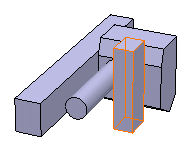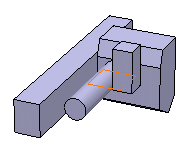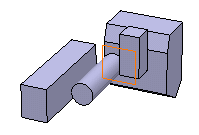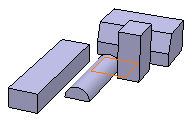In this task, you will add three feature modifiers, more precisely
three
cut features.
Click Cut
 in the Dress up & Modifiers toolbar (Feature Modifiers
sub-toolbar).
in the Dress up & Modifiers toolbar (Feature Modifiers
sub-toolbar).
The Cut dialog box appears.
Select the feature you want to cut.

Select the plane as the Cutting element.
Click OK.

Right-click the feature, in our example Shellable
Prism.1 and select the Parents/Children... .
The Parents and Children dialog box that appears
displays the relationship.

Repeat steps 1 to 3 by selecting Shellable Prism.2
and Shellable Prism.3 as the features to cut and yz
plane as the Cutting element.
Click OK.

Right-click Cut.2 and select the
Parents/Children....
The Parents and Children dialog that appears displays
the relationship.

Repeat steps 1 and 2 by selecting Shellable Prism.2
and Shellable Prism.4 as the features to cut.
You will notice that when Shellable Prism.2 is selected, Cut.2 is selected
instead. Also you cannot select Shellable Prism.3. This is because Cut.2
is the top of the chain and Cut.2 is already in the list of
the features to cut. Consequently, Cut.2 cannot be inserted a
second time.
You will notice Cut.2 has a modification overlay
icon applied in the specification tree.
Select xy plane as the Cutting element
and Click OK.

Right-click Cut.3 and select the Parents/Children....
The Parents and Children dialog that appears displays the
relationship.

Right-click Cut.2 in the specification tree
and select the Deactivate contextual command.
The Deactivate dialog box proposes you to
deactivate its children too.
Click OK to confirm.
Cut.2 and Cut.3 are deactivated.